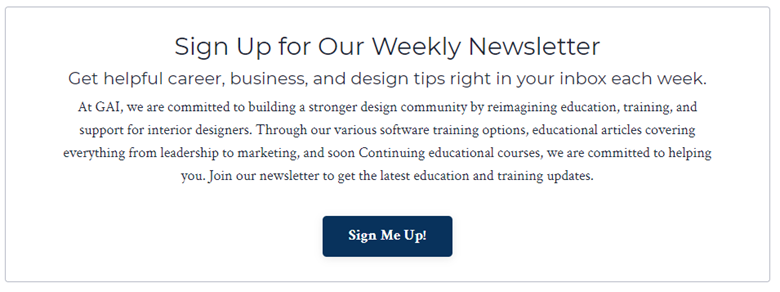8 Easy Steps to Converting Leads on Your Interior Design Website
Oct 22, 2021
You set your website up for success, followed the digital marketing sales funnel described in “How to Effectively Position Your Brand Using a Digital Marketing Funnel” to a T, and inspired your target audience enough to land on the perfectly curated website. You threw your line out, they bit, and you reeled them in - but now the ball is back in your court, you cannot let your fish drop off the line.
At this very moment, you have the power to bloom or doom your business. Your customers are knocking at your door, so let them in with strategically placed and worded calls to action (CTA). In this article, you will learn about the types of calls to action and how they can be used to grow your interior design business.
What is a CTA?
A CTA or call to action is an image or line of text on your website that prompts the user to take a specific action. The CTA is written as a command or action to take off the current page of general information to a detailed form, landing page, or article that relates to that prompt.
This is the make it or break it part for conversions. Without a solid CTA that guides users directly to the final stage of the marketing funnel, every new customer will feel lost.
4 Uses For a CTA
- To Build Up A Customer Base: Raising brand awareness by introducing your products, company, and overall aesthetic.
- To Make A Final Sale: The final step in the sales funnel is to start with brand awareness and eventually lead to a sale.
- To Generate Leads: Identifying their target audience as individuals with general interest likely to become future customers.
- To Form Email Lists: Every CTA’s analytics are recorded into the site’s backend that you can segment into clean email lists.
So sit back, relax, and uncover eight easy steps to make this happen.
1. Know Your Audience.
Before hitting the drawing board creating all things CTA, thoroughly understand your target audience. This can be an overwhelming task when pondering the millions of opinions, interests, and passions people have worldwide. Especially in such a broad industry like interior design, where your target audience potentially could be anyone holding the buying power needed to acquire your services. Which entails a variety of styles across the board.
Related Article: “How to Identify your Target Market for Increased Profitability”
Be sure to discover what drives them, makes them tick, and most importantly, what they attribute to pain and pleasure so you can speak directly to whatever you feel would inspire them. You will find this stage a lot of fun when you finally determine the messaging that appeals to your customers’ emotional and physical well-being. Then, after a complete understanding of the unique personas your users carry, and what motivates them, you can test out several different approaches to narrow down the most successful narrative.
The more relevant your CTA is, the more likely visitors will click the whole way through. Additionally, the sooner you can segment your audience by their significant interests, the sooner you can make them an offer they just cannot refuse.
2. Let Your Audience Know Exactly What You Want Them To Do.
Use verbiage specifically catered to your target audience, so they do not feel the content is irrelevant to them. Try not to use generic CTA’s like “signup,” “download,” etc. Instead, give them a clear, concise reason why they should take the desired action in a short and sweet manner. The CTA button should be a little summary of the content stated around or above it.
For example, after reading an article about interior design: instead of using “learn more” as the desired action to conclude the information, use “stay in the loop on all things design.” This allows the user to feel welcomed and part of the club, fostering a positive emotion around your brand.
3. Use Emotion-Provoking Language.
When statements like “Take Your Dream Vacation Today” or “Step Into The Home You’ve Always Dreamt About” are read or spoken to you, what comes to mind?
A sense of freedom? The need for a break? Anger, knowing neither, are currently possible? Envy, of those able to get that? A sense of relief? Fear of missing out?
Whatever it may be, your customers are also feeling it. Using detailed CTAs like these, versus “sign up today” or “take me to more info,” places the user right where they need to be. On the frontline, where their demand matches your supply.
As stated above, guarantee your customers and potential customers know what you want them to do and what they get in return. Fully meeting the needs of your consumers through CTA/Sales funneling includes stating the time it will take to acquire the reward. For example, instead of using “Free eBook,” opt for “Download Your Free eBook Now.” This positions the consumer to get the product immediately - and in most cases, the CTA links to instant gratification.
4. Amplify Your USP.
A USP is the unique selling proposition your products, services, and calls to action are based on. This is whatever you can offer differently from the competition around you. Your USP is one of the fundamental pieces of a solid marketing plan.
Register now for “Building a Brand Beyond Logos: How Interior Designers Can Build a Brand” continuing education course.
In order to accomplish this, you must first understand what your audience is looking for. Then explain the problem you solve for them, followed by listing the biggest distinctive benefits you offer. Once those are defined, write and cut down your unique selling proposition to clearly state your promise to all customers.
5. Try a Variety of Perspectives.
Profitable calls to action are not spoken from any particular perspective. However, a single word can make a world of difference, so choose wisely. Changing the verbiage from “Download Your eBook Today” to “Download My eBook Today” could be exactly what you need to boost your conversion rates. Using first-person, for example, personalizes the CTA to generate a feeling of inclusivity and ownership.
6. Switch Up the Color Palette.
I know, I know - you just handcrafted and perfected your branding color scheme, and now we are telling you to change it up! Not necessarily.
Colors used for your calls to action should be bold accents, not permanent additions to your company’s standard hex palette. While most of your branding and website should stay uniform to instill brand recognition, this is a place where you could and should let your creativity run wild.
Surprisingly, many studies have shown that green and orange colors perform best in calls to action. Use this space as one to experiment with combining your expected feeling portrayed and the science of color.
6. Get Creative.
CTA’s are a form of pay-per-click conversions, which is typically a frustrating game of trial and error. So, whether you are in the experimental phase looking to gain traction or have already found several tried and true tactics but are looking to spice things up a little, throw some creativity in there. Using good old-fashioned A-B testing to figure out the perfect CTA equation can help you identify what will bring smiles or frowns to viewers’ faces.
Instead of using → “Check Out Today’s Deals,” try using → “Tons Of Deals Right At Your Fingertips.”
Instead of using → “Fill Out This Form To Get Started,” try using → “A Healthier Life Starts Now.”
You will never know for sure if something will or will not work out without trying it. Sorry to say, many audiences do not respond well to generic or even “surefire” CTA’s. Instead, they are looking for a unique approach taken by that company - many fail the test with this group, will you?
Sometimes all they are looking for is some relatable, down-to-Earth content that uses a little slang. This can be a bit tricky to pull off, and definitely use this technique sparingly. For example, if I was looking to fix brown patches in my grass and I came across an ad with a CTA that stated, “your yard sucks, let us fix it,”; Not only would it catch my attention, but because the gesture was so clever, I would probably click on it. You are walking a fine line between professional and unprofessional, but it can pay off big time - you will never know until you try.
7. Take Advantage of FOMO.
FOMO, otherwise known as fear of missing out, is an extremely effective motivator. Absolutely nobody likes to feel left out, especially when the product or experience has a strong emotional attachment to that individual. So when people feel like they will lose an opportunity that might not come around again, they are likely to jump on the bandwagon.
Do this by mentioning a sale or promotion that your company is holding and will not last forever. Then, use messaging like “Shop Today! Sale Ends Monday!” or “Buy Now, While Supplies Last” to hook, line, and reel them in.
8. Optimize for All Screen Sizes
There is no secret that creating eye-catching CTA’s is crucial. But, there sincerely is no need to go through all the work of making killer calls-to-action if they can only be seen on a computer screen. You will lose over half of your potential conversions by neglecting to fit the CTA to all screen sizes.
An easy way to ensure this can be done by one or more of these tips:
The first and simplest way happens directly on your website. On each page, hold down CTRL + SHIFT + (I). This will pop up a screen that minimizes your current one down to the desired size. Up in the left-hand corner, you will see a drop-down menu for the screen you are trying to view. There are twelve options consisting of almost all phone screens and tablet sizes.
Google gives you the option to set a screen size preference for your ads. This allows you to designate certain ads on mobile screens versus full width to snap down correctly.
Another viable option is to opt for one-touch dialing by enabling call extensions. For example, Google allows you to display a small “Call” button alongside your ads which removes the need for customers to search your number.
At the End of The Day
There is not a single company on Earth that has it all figured out. When launching marketing efforts and strategic plans, brands can have outcome expectations, but the reality is they are just playing a massive game of trial and error. Your company must have patience and a dynamic work ethic that can easily shift gears.
Try out a variety of approaches mixed with a few of these tips to unveil the winning potion for CTA success.
Want to know more about branding? Check out our newly launched course "Build Your Brand Identity Beyond Logos: How Interior Designers Can Use Branding to Build a Successful Design Business". This is a 1.5 IDCEC credited course and is $49!
Also check out our newest guide, "25 Ways for You to Drive More Traffic". These actionable strategies are completely free and designed to help you boost your online presence and grow your audience. Dive in and start attracting more traffic to your website today!
Sign Up for Our Monthly Newsletter
Get helpful career, business, and design tips right in your inbox each month.
At Behind the Design, we are committed to building a stronger design community by reimagining education, training, and support for interior designers. Through our various software training options, educational articles covering everything from leadership to marketing, and soon Continuing educational courses, we are committed to helping you. Join our newsletter to get the latest education and training updates.












